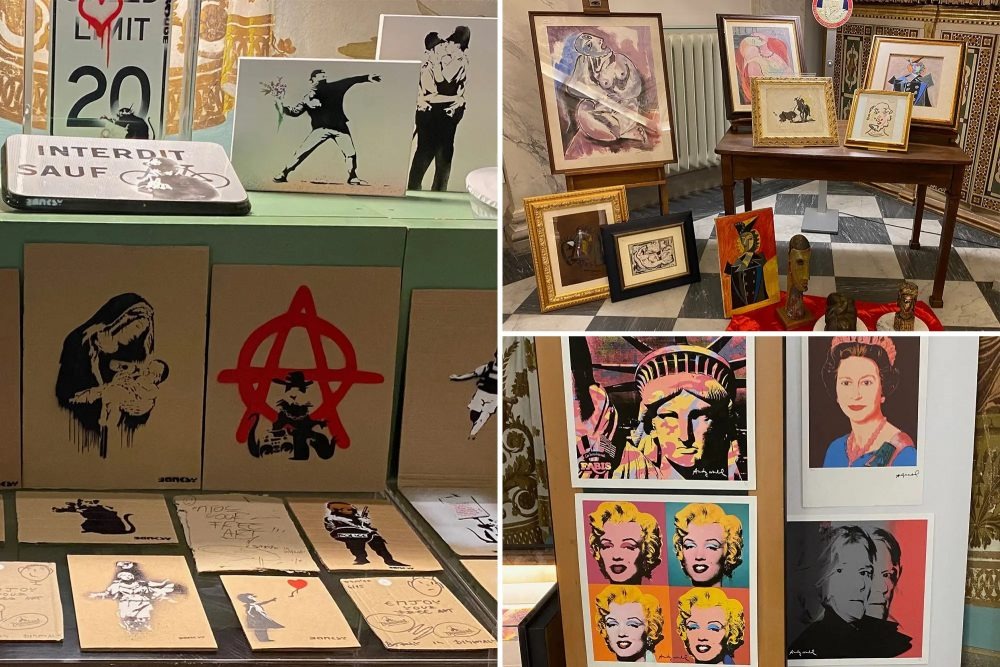Banksy forgeries are at the heart of a massive European art scandal that has left collectors and critics stunned. Italian police recently uncovered a sprawling network of counterfeiters forging artworks by some of the biggest names in modern and contemporary art.
Alongside Banksy, fake pieces attributed to legends like Pablo Picasso, Andy Warhol, and Salvador Dalí have surfaced, shaking trust in the art market.
Authorities revealed that 38 people across Italy, Spain, France, and Belgium are under investigation for handling stolen goods, forgery, and the illegal sale of art. The operation is being hailed as a landmark in protecting Banksy’s legacy.
How the Banksy Forgeries Network Was Uncovered
The investigation into Banksy’s forgeries began in 2023 when Italian authorities stumbled upon 200 counterfeit artworks in Pisa. Among the collection, they found a fake Modigliani piece, which sparked a deeper probe. What they uncovered was jaw-dropping: a network that extended across Europe, operating forgery workshops in Italy, Spain, and beyond.

Two of the workshops were located in Tuscany, another in Venice, while others dotted the rest of Europe. From these hubs, forgers produced imitations of works by Banksy and other renowned artists. Thus, funneling them into auction houses and private collections.
Banksy’s Legacy Is Under Threat
Banksy forgeries have long plagued the art market, but this latest network takes the deception to a new level. Pest Control, Banksy’s official authentication body, has repeatedly warned buyers about the prevalence of “expensive fakes.” Yet, the scale and sophistication of this operation highlight how vulnerable the market remains to exploitation.
To add a veneer of legitimacy, the suspects organized two exhibitions dedicated to Banksy’s work in prestigious venues in Venice and Tuscany. These events, complete with glossy catalogs, tricked even seasoned collectors into believing they were purchasing authentic Banksy pieces.
Why Banksy Forgeries Are So Hard to Detect
Banksy’s anonymity and unconventional approach to art make his works particularly susceptible to forgery. Without a face or a centralized studio, buyers often rely on Pest Control for authentication. But even this system has its limits. The counterfeiters exploited gaps in the verification process, passing off high-quality imitations as genuine works.
The network uncovered in Italy went further, crafting forgeries so convincing they fooled auction houses. Thus, the operation highlights the importance of expert oversight and the need for stricter measures in the art market.
The Scale of the European Forgery Network
While Banksy’s forgeries grabbed headlines, the counterfeit network extended far beyond one artist. Authorities revealed that the group forged works attributed to Vincent van Gogh, Marc Chagall, Francis Bacon, and many others.
Each piece was carefully designed to pass as an original. The worst part? It targeted wealthy buyers and galleries who were willing to pay top dollar for masterpieces.
The suspects spared no effort in their deceptio
n. Investigators believe the network relied on skilled artisans and sophisticated tools to replicate the look and feel of authentic works. From aged paper to faded paint, every detail was meticulously crafted to fool even seasoned art connoisseurs.
How Bad Is It for the Art Market?
The Banksy forgeries network underscores a glaring vulnerability in the art world: the reliance on trust. Collectors often base purchases on reputation and provenance. However, as this scandal shows, even the most trusted sources can be duped. The operation’s €200 million market value demonstrates how lucrative and damaging art forgery can be.
So, for genuine artists like Banksy, this scandal poses a dual threat: Financial loss and damage to reputation. Buyers hesitant to invest in contemporary art might shy away altogether.
General Disclaimer: The information provided in this blog is for informational purposes only. Newlo Pedia makes no warranties regarding the accuracy or completeness of the content. Readers are advised to verify details independently before making decisions based on the information provided.
Content Disclaimer:This blog is intended to share general knowledge and insights. It is not meant to replace professional advice or guidance. Newlo Pedia does not endorse or guarantee the accuracy of any information presented here.
Advertising Disclaimer:This blog may include affiliate links or advertising content. Newlo Pedia may earn a commission from purchases made through these links, which helps support the platform. However, all opinions expressed are independent and based on our editorial standards.
Affiliate Disclosure:Some links in this blog may direct you to external websites, and Newlo Pedia may receive a commission for purchases made through these links. This does not influence the integrity or neutrality of the content provided.
Third-Party Links Disclaimer: This blog may contain links to third-party websites. Newlo Pedia does not assume responsibility for the accuracy, content, or policies of external websites. Readers are encouraged to review the terms and privacy policies of linked sites.
Legal Disclaimer: Newlo Pedia does not guarantee the safety, reliability, or quality of any products, services, or recommendations mentioned in this blog. Use any information or purchase products at your own discretion and risk.
Stock Image Disclaimer: Images featured in this blog are for illustrative purposes only. They may not reflect actual locations, products, or scenarios discussed in the content. These images are intended solely to enhance the reader’s experience.
Results Disclosure: The experiences or suggestions mentioned in this blog may vary from person to person. Outcomes are not guaranteed and depend on various factors, including individual preferences and circumstances.
Copyright Disclaimer: This content is the property of Newlo Pedia and is intended for personal use only. Redistribution or unauthorized use of this blog’s content is strictly prohibited.







